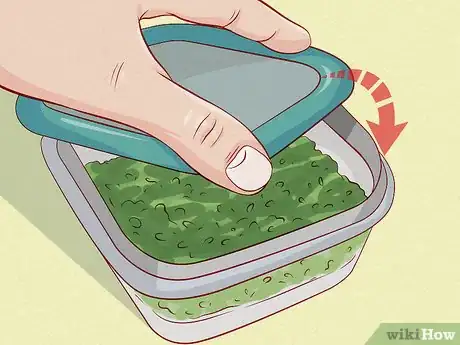This article was co-authored by Ollie George Cigliano. Ollie George Cigliano is a Private Chef, Food Educator, and Owner of Ollie George Cooks, based in Long Beach, California. With over 20 years of experience, she specializes in utilizing fresh, fun ingredients and mixing traditional and innovative cooking techniques. Ollie George holds a BA in Comparative Literature from The University of California, Berkeley, and a Nutrition and Healthy Living Certificate from eCornell University.
There are 7 references cited in this article, which can be found at the bottom of the page.
wikiHow marks an article as reader-approved once it receives enough positive feedback. In this case, 100% of readers who voted found the article helpful, earning it our reader-approved status.
This article has been viewed 67,998 times.
Maybe your rosemary bush suddenly started producing, or there was a sale at the supermarket you couldn’t pass up. Either way, you find yourself with lots of extra rosemary and not enough time to use it. Luckily, there are a few simple tricks to ensure that your rosemary won’t go bad before you get the chance to cook with it. You can store it in the refrigerator, use a freezer for longer-term storage, or even dry your sprigs for maximum shelf life. You’ll be enjoying your rosemary for weeks or even months to come!
Steps
Freezing Rosemary Sprigs
-
1Wash and dry your rosemary. Rinse the sprigs in cool water and lay them flat to dry, patting them with a paper towel to speed up the process. You can also use a salad spinner, if you have one.
-
2Place the sprigs on a baking sheet. Keep the leaves attached to the stem and spread the sprigs out on the sheet in a single, even layer. Try not to let the sprigs touch each other, as they might freeze together! You can place them directly on the sheet or on a piece of parchment paper.[1]Advertisement
-
3Freeze the rosemary for a few hours. Check on them every half an hour or so and leave them in the freezer until they’re frozen solid. This means you shouldn’t be able to bend them very easily, and that the leaves shouldn’t droop or move at all when you pick up a sprig.[2]
- Freezing the rosemary first on the tray will allow each sprig to freeze separately and not get stuck to any others. It will also allow for a faster and more thorough freeze than if the sprigs were in a freezer bag.
-
4Put the frozen sprigs in a freezer bag. Zip them up tight and press all the air out of the bag to conserve freezer space. Write the date on the container so you’ll know how old the rosemary is if you forget or lose track of it in the freezer. Finally, place your rosemary back in the freezer.
-
5Keep your rosemary for several months to a year. Depending on the quality of your freezer, your rosemary should stay fresh for about a year or even longer. Check on it every month or so to see if it’s still good to use, keeping an eye out for signs of browning or mold.[3] When you’re ready to cook with your rosemary, you can grab it right from the freezer bag; no need to let it thaw out.[4]
Storing Rosemary in the Refrigerator
-
1Wash your rosemary. Rinse the sprigs in cool water and lay them on a paper towel to dry. Use a salad spinner if you have one. Otherwise, simply pat them thoroughly with a second paper towel.[5]
- Excess water will cause the rosemary to get slimy when you store it, so make sure your sprigs are totally dry.
-
2Wrap your rosemary in a damp paper towel. Keep the sprigs whole and uncut. The damp paper towel will prevent them from drying out in the refrigerator.[6]
-
3Place the sprigs in a resealable bag. This will protect the sprigs from oxygen, which can cause them to spoil and turn brown. You can use a Ziploc bag or an airtight container.[7]
- You can write the date on the bag or container so you don’t forget how long your rosemary has been in the refrigerator.
-
4Put the bag in the crisper drawer of your refrigerator. Set the humidity to high.[8] With your bag or container firmly sealed, your rosemary should stay fresh for up to 2 weeks.[9]
- Rosemary is still good as long as it’s green and fresh-looking. When it gets to be black or brown and a little slimy, it’s gone bad.
Air-Drying Rosemary
-
1Wash and dry your rosemary. Rinse the sprigs with cool water and lay them flat to dry. You can pat them with a paper towel or use a salad spinner to help them dry faster.
-
2Remove the lower leaves from your rosemary. Tear off the leaves from the lower part of the sprigs, about 1 to 2 inches (2.5 to 5.1 cm) up from the bottom. This is where you’ll be tying your rosemary to hang it up.[10]
-
3Tie the rosemary in bunches with twine. Turn the sprigs so that they’re all facing the same direction. Gather a small handful of sprigs, enough to fit comfortably in your palm. The exact amount of rosemary in each bunch doesn’t matter as much as keeping all the bunches mostly even. Tie each bunch at the bottom using twine, a rubber band, or twist ties.[11]
- Tie the string tight, but allow the bunches themselves to be looser at the top so that the air can circulate through.
-
4Hang the bunches to dry in a dark, clean area. You can use a basement, spare bedroom, or closet as a storage space. Hang your rosemary from a clothesline, laundry rack, or exposed rack. Use clothespins or pieces of string a few inches long to tie and hang up the sprigs.[12]
- Wherever you store your sprigs, make sure they’re out of direct sunlight and away from cooking oils, smoke, dust, and steam. They should be kept as dry and clean as possible to get the best quality and flavor.
-
5Check on the rosemary every few days. Pinch them a bit to see how they crumble. If they fall in flakes, they’re ready to go! You can also place a few leaves into a glass jar or plastic bag and seal it tightly. If condensation gathers on the inside of the jar or bag, your rosemary needs a bit more time to dry. The process could take anywhere from a couple weeks to a few months, so be patient! [13]
- If the sprigs disintegrate into powder when you pinch them, they’re over-dried. This is why it’s important to check on your sprigs every few days, or even more frequently as they get closer to being ready. You won’t be able to salvage your rosemary once it’s been dried for too long.
-
6Store your dried rosemary in airtight containers. Cut the leaves from the stems and place them in an airtight jar or resealable plastic bag.[14] You can crumble your rosemary before storing or store them whole, then crumble them when you’re ready to cook.[15] Your dried rosemary should last for a year in a pantry or cabinet.
Drying Rosemary in the Oven
-
1Wash and dry your rosemary. Use cool water and pat the sprigs dry with a paper towel. Let them sit for 10-15 minutes to air dry completely, as baking the herbs while still damp will make the process take much longer.[16]
-
2Lay the sprigs on a baking sheet. Line the baking sheet with parchment paper first, then space the sprigs evenly apart. You can always use more than one baking sheet if you need more space![17]
-
3Set the oven to the lowest temperature possible. This will allow your rosemary to bake slowly, but not burn. Place the baking sheet inside, close to the middle of the oven.
-
4Let the rosemary bake for 30 minutes. About 15 minutes into the baking, open the oven door for about a minute to let the moisture out, which will allow your rosemary to bake more quickly. After 30 minutes, check on the herbs by using oven mitts to crumble them a bit. If they flake apart in your fingers, they’re done! If not, put the sheet back in the oven and check back in about 15 minutes. The rosemary shouldn’t take more than an hour to bake![18]
-
5Let the rosemary cool completely. Remove the sprigs from the sheet and place them on a flat, clean surface. Once the rosemary is cool, you can remove the leaves from the stems if desired, crumble them, or keep the sprigs whole if you want to use a larger sprig in cooking or as a garnish.[19]
- It’s important that the rosemary is totally dry before you store it. Any heat will create moisture in the container, which can cause mold.
-
6Store the rosemary in an airtight container. You can use a jar, a plastic container, or even a resealable bag. For the best taste, use up your dried rosemary within one year. It will still be good to eat after that time, but may not have as strong a flavor.
References
- ↑ https://www.thekitchn.com/4-ways-to-preserve-fresh-rosemary-221277
- ↑ https://www.thekitchn.com/4-ways-to-preserve-fresh-rosemary-221277
- ↑ https://www.thekitchn.com/4-ways-to-preserve-fresh-rosemary-221277
- ↑ https://www.splendidtable.org/story/how-to-freeze-fresh-herbs-whole-or-as-flavoring-blends
- ↑ https://www.todayshomeowner.com/how-to-air-dry-fresh-herbs/
- ↑ https://www.thekitchn.com/your-guide-to-storing-fresh-herbs-in-the-fridge-231412
- ↑ https://www.thekitchn.com/your-guide-to-storing-fresh-herbs-in-the-fridge-231412
- ↑ https://www.thekitchn.com/what-to-store-in-your-refrigerator-humidity-drawers-tips-from-the-kitchn-178094
- ↑ https://www.thekitchn.com/4-ways-to-preserve-fresh-rosemary-221277
- ↑ https://www.todayshomeowner.com/how-to-air-dry-fresh-herbs/
- ↑ https://www.todayshomeowner.com/how-to-air-dry-fresh-herbs/
- ↑ https://www.todayshomeowner.com/how-to-air-dry-fresh-herbs/
- ↑ https://www.todayshomeowner.com/how-to-air-dry-fresh-herbs/
- ↑ https://www.epicurious.com/expert-advice/how-to-dry-rosemary-step-by-step-article
- ↑ https://www.todayshomeowner.com/how-to-air-dry-fresh-herbs/
- ↑ http://www.wifemamafoodie.com/dry-fresh-herbs-oven/
- ↑ http://www.wifemamafoodie.com/dry-fresh-herbs-oven/
- ↑ http://www.wifemamafoodie.com/dry-fresh-herbs-oven/
- ↑ http://www.wifemamafoodie.com/dry-fresh-herbs-oven/
About This Article
To store fresh rosemary, first rinse the sprigs in cool water and pat them dry with a paper towel. Then, wrap the whole, uncut sprigs in a damp paper towel to prevent them from drying out. Place the wrapped sprigs in a resealable plastic bag or an airtight container. Write the date on the bag or container. Store the sprigs in the crisper drawer of your refrigerator and set the humidity in the drawer to high. You can store the rosemary here for up to 2 weeks before it will begin to turn brown and lose its freshness. If you want to learn how to dry or freeze the rosemary, keep reading!











































































